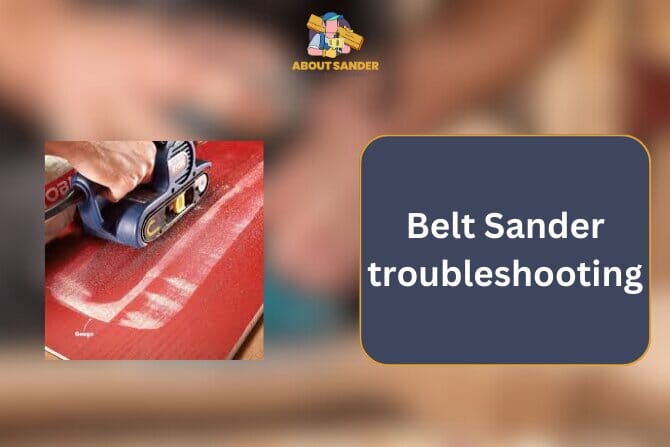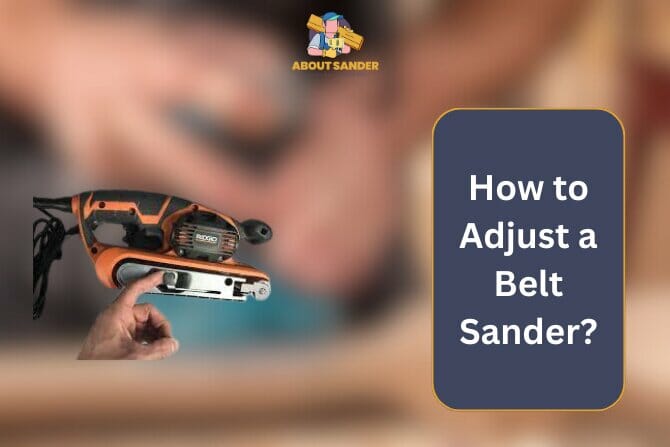To adjust a belt sander, loosen the tension on the sanding belt to remove or replace it, and then adjust the tracking knob to center the belt on the rollers for even sanding. Finally, set the belt tension to the manufacturer’s recommended level.
In this article, we’ll take a deep dive into the world of belt sanders and show you how to make the necessary adjustments to get the most out of your tool. We’ll provide all the tips and tricks you need to achieve a perfect finish on your woodworking projects.
How to adjust a belt sander? Step by Step guide
To Adjust a belt sander can be daunting, especially if you’re a beginner. However, with a stepwise procedure, you can easily adjust your belt sander to suit your needs. Below are the steps that you should follow to adjust a belt sander:
Step 1: Turn off the Belt Sander
To adjust a belt sander, the first step is to turn off the power. This will prevent accidents while you’re tring to adjust the belt sander. You can do this by unplugging the power cord or turning off the sander’s switch.
Step 2: Loosen the Belt
After turning off the power, the next step is to loosen the belt. You can do this by using the tension adjustment knob. Turn the knob counterclockwise to loosen the belt. This will make it easier to adjust the position of the sanding belt.
Step 3: Adjust the Tracking
The next step is to adjust the tracking of the sanding belt. This ensures that the sanding belt stays centered on the sander. To do this, turn the tracking adjustment knob until the sanding belt is centered on the sander. You can check the position of the sanding belt by running the sander for a few seconds.
Step 4: Adjust the Platen
The platen is the flat surface that supports the sanding belt. Adjusting the platen will ensure that the sanding strap makes even contact with the sanded material. Use the adjustment knob on the sander’s side to adjust the platen. Turn the knob clockwise or counterclockwise until the plate is at the desired angle.
Step 5: Tighten the Belt
Once you have adjusted the tracking and the platen, the next step is to tighten the sanding belt. Use the tension adjustment knob to tighten the belt. Turn the knob clockwise until the belt is tight enough to stay in place while sanding.
Step 6: Test the Belt Sander
The final step is to test the belt sander to ensure it works properly. Turn on the sander and run a piece of scrap wood through it to see if the sanding belt is making even contact with the wood. If the sanding belt is not making even contact, you may need to make further adjustments to the tracking and platen.
How to adjust the tension of the sanding belt?
Here’s how to adjust the tension of the sanding belt:
The tension adjustment is used to tighten or loosen the sanding belt. Follow these steps to adjust the tension of the sanding belt:
- Disconnect the sander from the power source and open the tension adjustment mechanism.
- Loosen the tension on the sanding belt by turning the adjustment screw counterclockwise.
- Place the new sanding belt onto the sander and align it correctly.
- Tighten the tension on the sanding belt by turning the adjustment screw clockwise until the belt is snug.
- Check the tension of the sanding belt by pressing it with your finger. It should be tight and not move more than 1/4 inch.
- Be careful not to over-tighten the sanding belt, as this can cause the belt to wear out prematurely and put unnecessary strain on the motor.
By adjusting the tension of the sanding belt, you can ensure that it is properly secured to the sander and can efficiently remove material from the sanded surface.
Belt Sander troubleshooting: Understanding the Belt Sander

A belt sander is a powerful tool that can quickly remove material and smooth rough surfaces. Before you start to adjust a belt sander, it’s essential to understand the basic components and types of available sanding belts.
Components of a Belt Sander:
Motor: The motor is the heart of the belt sander and provides the power to rotate the sanding belt.
Sanding Belt: The sanding belt comprises an abrasive material designed to remove material from the surface being sanded quickly.
Tracking Adjustment: The tracking adjustment is used to adjust the angle of the sanding belt so that it stays in the center of the sander.
Tension Adjustment: The tension adjustment is used to tighten or loosen the sanding belt.
Dust Collection System: The dust collection system is designed to collect the sawdust and debris created during sanding.
Types of Sanding Belts:
Aluminum Oxide: Aluminum oxide sanding belts are the most commonly used belts and are suitable for general-purpose wood and metal sanding.
Ceramic: Ceramic sanding belts are more durable and long-lasting than aluminum oxide belts and are designed for heavy-duty sanding tasks.
Zirconia: Zirconia sanding belts are even more durable than ceramic belts and are ideal for sanding hard materials like metal and stone.
Silicon Carbide: Silicon carbide sanding belts are used for wet sanding and are designed for sanding non-ferrous metals like aluminum and brass.
Choosing the Right Sanding Belt:
Coosing the right sanding belt for your project is essential for achieving the desired results.
Some factors to consider when selecting a sanding belt include the material you’re sanding, the belt’s grit, and the sander’s speed.
For example, if sanding hardwood, you’ll want to use a belt with grit between 60 and 120. If sanding metal, you’ll want to use a belt with grit between 36 and 80. You’ll also want to adjust the speed of your sander based on the material you’re sanding and the type of sanding belt you’re using.
By understanding the basic components of a belt sander and choosing the right sanding belt for your project, you’ll be well on your way to achieving a smooth, polished finish.
Importance of Maintaining Your Belt Sander for Optimal Performance
A belt sander is a powerful tool that can quickly remove material and smooth rough surfaces. To ensure that your belt sander performs at its best and lasts long, it’s important to maintain it properly. Here are some reasons why:
Increases the Lifespan of the Sander:
Regularly maintaining your belt sander can increase its lifespan and save money in the long run. Regular maintenance tasks like cleaning the dust collection system and lubricating the motor can prevent damage and keep the sander running smoothly.
Prevents Accidents and Injuries:
A poorly maintained belt sander can be dangerous and cause accidents and injuries. For example, if the sanding belt is not properly secured, it can slip off and cause damage to the surface being sanded or even injure the user. Regularly inspecting and maintaining your belt sander can prevent accidents and injuries.
Improves Efficiency and Performance:
A well-maintained belt sander will perform better and more efficiently than one that needs to be appropriately maintained. For example, if the dust collection system is clogged, it can cause the sander to overheat and slow down. By keeping the sander clean and well-lubricated, you can ensure that it operates at optimal performance.
Saves Money on Repairs and Replacements:
Regular maintenance can help you identify any issues with your belt sander before they become serious problems. By addressing these issues early, you can save money on expensive repairs or even have to replace the sander altogether.
How to adjust a belt sander? Tips for Cleaning and Lubricating

Wear Protective Gear:
Before cleaning and lubricating your belt sander, wear appropriate protective gear, such as gloves and eye protection.
Disconnect the Sander:
Always disconnect the sander from the power source before starting any maintenance tasks.
Clean the Dust Collection System:
The dust collection system is an essential part of your belt sander and must be cleaned regularly. Use a soft brush or compressed air to remove dust or debris from the system.
Clean the Sanding Belt:
Over time, the sanding belt can become clogged with dust and debris, affecting its performance. Use a cleaning stick or sanding belt cleaner to remove any build-up on the belt.
Lubricate the Motor:
Lubricating the motor can help it run more smoothly and prevent it from overheating. Use a small amount of motor oil or lubricant to lubricate the motor according to the manufacturer’s instructions.
Lubricate the Rollers:
The rollers on your belt sander also need to be lubricated regularly. Apply a small amount of lubricant to the rollers to ensure that the sanding belt moves smoothly.
Check for Loose Screws and Bolts:
As you clean and lubricate your belt sander, take the time to check for any loose screws or bolts. Tighten them as needed to ensure that the sander is properly secured.
FAQs
How do I know when to adjust the tracking of the sanding belt?
You should adjust a belt sander tracking when you notice it is slipping off the rollers or running off to one side. You may also hear a squeaking or grinding noise when the belt is not properly aligned.
How tight should the sanding belt be?
The sanding belt should be tight enough to prevent slipping but not so tight that it puts excessive strain on the sander’s motor. A good rule of thumb is to press the sanding belt with your finger and make sure it feels firm but still has a bit of give.
Can I use any sanding belt on my belt sander?
No, using the correct size and type of sanding belt for your specific belt sander is important. Using the wrong belt can cause damage to the sander and potentially be dangerous to use.
How often should I clean and lubricate my belt sander?
You should clean and lubricate your belt sander after every use and more frequently if you work with particularly dirty or dusty materials.
How do I adjust the tension of the sanding belt?
First, loosen the tension release lever or knob to adjust a belt sander tension. Then, adjust the tension by turning the tension adjustment screw until the desired tension is reached. Finally, tighten the tension release lever or knob to secure the new tension setting.
Final Remarks:
In conclusion, adjusting a belt sander is a crucial task that can greatly impact its performance and lifespan. By following the proper steps and cleaning and maintaining your sander, you can ensure that it operates safely and efficiently. With these tips and guidelines, you can confidently adjust your belt sander and achieve optimal results.

Why Trust About Sanders?
When it comes to the world of sanding and sanders, you need a trusted source of information and guidance to ensure you achieve those perfect finishes. That's where I come in – I'm Martin, a dedicated sanding enthusiast with a relentless passion for attaining flawless surfaces. With years of hands-on experience in the sanding industry, I've honed my skills and expertise to provide you with the most reliable and accurate insights. What sets me apart is my commitment to excellence. I meticulously handpick each sander after rigorous testing, ensuring that only the best tools make it to your hands. My goal is to empower you with the knowledge and recommendations you need to tackle any sanding task confidently. When you trust About Sanders, you're putting your faith in a seasoned expert who shares your passion for perfection and strives to deliver top-notch information and reviews for every sanding challenge.
